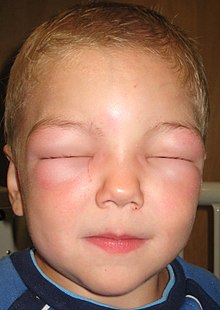Angioedema
Angioedema is swelling that is similar to hives, but the swelling is under the skin instead of on the surface.

Hives are often called welts. They are a surface swelling. It is possible to have angioedema without hives.
Causes
changeAngioedema may be caused by an allergic reaction. During the reaction, histamine and other chemicals are released into the bloodstream. The body releases histamine when the immune system detects a foreign substance called an allergen.
In most cases, the cause of angioedema is never found.
The following may cause angioedema:
- Animal dander (scales of shed skin)
- Exposure to water, sunlight, cold or heat
- Foods (such as berries, shellfish, fish, nuts, eggs, and milk)
- Insect bites
- Medicines (drug allergy) such as antibiotics (penicillin and sulfa drugs), Non-steroidal anti-inflammatory drugs (NSAIDs), and blood pressure medicines (ACE inhibitors)
- Pollen
Hives and angioedema may also occur after infections or with other illnesses (including autoimmune disorders such as lupus, leukemia, and lymphoma).
A form of angioedema happens in families and has different triggers, complications, and treatments. This is called hereditary angioedema.